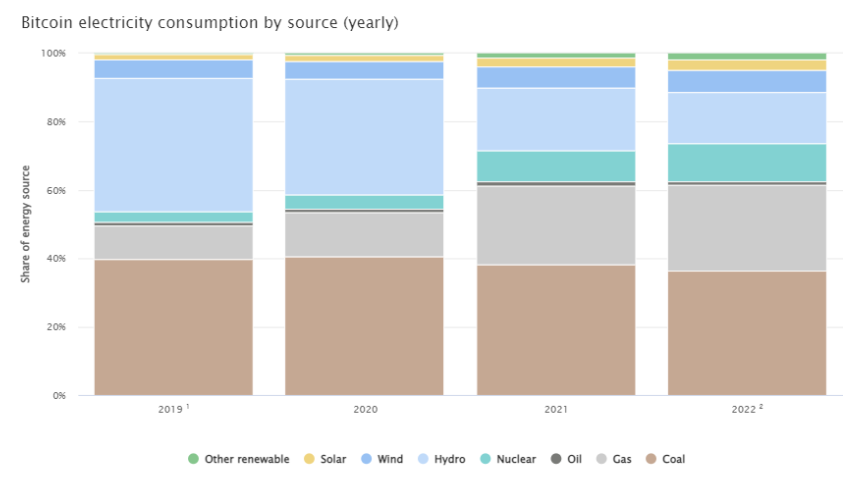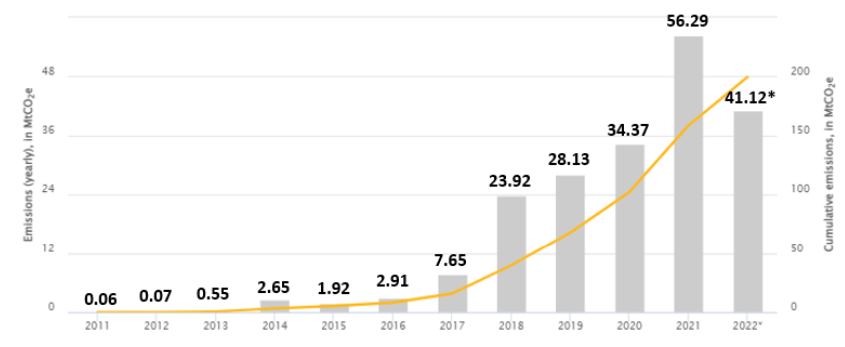The electricity mix of Bitcoin (BTC) has drastically changed over the past few years, with nuclear energy and natural gas becoming the fastest growing energy sources powering Bitcoin mining, according to new data.
The Cambridge Centre for Alternative Finance (CCAF) on Tuesday released a major update to its Bitcoin mining-dedicated data source, the Cambridge Bitcoin Electricity Consumption Index (CBECI).
According to the data from Cambridge, fossil fuels like coal and natural gas made up almost two-thirds of Bitcoin’s total electricity mix as of January 2022, accounting for more than 62%. As such, the share of sustainable energy sources in the BTC energy mix amounted to 38%.
The new study suggests that coal alone accounted for nearly 37% of Bitcoin’s total electricity consumption as of early 2022, becoming the largest single energy source for BTC mining. Among sustainable energy sources, hydropower was found to be the largest resource, with a share of roughly 15%.
Despite Bitcoin mining significantly relying on coal and hydropower, the shares of these energy sources in the total BTC energy mix have been dropping over the past several years. In 2020, coal power powered 40% of global BTC mining. Hydropower’s share has more than halved from 2020 to 2021, tumbling from 34% to 15%.

In contrast, the role of natural gas and nuclear energy in Bitcoin mining has been notably growing over the past two years. The share of gas in the BTC electricity mix surged from about 13% in 2020 to 23% in 2021, while the percentage of nuclear energy increased from 4% in 2021 to nearly 9% in 2022.
According to Cambridge analysts, Chinese miner relocations were a major reason behind sharp fluctuations in Bitcoin’s energy mix in 2020 and 2021. China’s crackdown on crypto in 2021 and the associated miner migration resulted in a major drop in the share of hydroelectric power in the BTC energy mix. As previously reported, Chinese authorities shut down a number of crypto mining farms powered by hydroelectricity in 2021.
“The Chinese government's ban on cryptocurrency mining and the resulting shift in Bitcoin mining activity to other countries negatively impacted Bitcoin's environmental footprint,” the study suggested.
The analysts also emphasized that the BTC electricity mix hugely varies depending on the region. Countries like Kazakhstan still rely heavily on fossil fuels, while in countries like Sweden, the share of sustainable energy sources in electricity generation is about 98%.
The surge of nuclear and gas energy in Bitcoin's electricity mix allegedly reflects the “shift of mining power towards the United States,” the analysts stated. According to the U.S. Energy Information Administration, most of the nation’s electricity was generated by natural gas, which accounted for more than 38% of the country’s total electricity production. Coal and nuclear energy accounted for 22% and 19%, respectively.
Among other insights related to the latest CBECI update, the study also found that greenhouse gas (GHG) emissions associated with BTC mining accounted for 48 million tons of carbon dioxide equivalent (MTCO2e) as of Sept. 21, 2022. That is 14% lower than the estimated GHG emissions in 2021. According to the study’s estimates, the current GHG emissions levels related to Bitcoin represent roughly 0.1% of global GHG emissions.
Combining all the previously mentioned findings, the index estimates that by mid-September, about 199.6 MtCO2e can be attributed to the Bitcoin network since its inception. The analysts stressed that about 92% of all emissions have occurred since 2018.

As previously reported, the CCAF has been working on CBECI as part of its multi-year research initiative known as the Cambridge Digital Assets Programme (CDAP). The CDAP's institutional collaborators include finance institutions like British International Investment, the Dubai International Finance Centre, Accenture, EY, Fidelity, Mastercard, Visa and others.
Related: Bitcoin could become a zero-emission network: Report
The new CDAP findings noticeably differ from data by the Bitcoin Mining Council (BMC), which in July estimated the share of sustainable sources in Bitcoin's electricity mix at nearly 60%.
“It doesn’t include nuclear or fossil fuels so from that you can imply that around 30-40% of the industry is powered by fossil fuels,” Bitfarms chief mining officer Ben Gagnon told Cointelegraph in August.
According to CBECI project lead Alexander Neumueller, the CDAP’s approach is different from the Bitcoin Mining Council when it comes to estimating Bitcoin’s electricity mix.
“We use information from our mining map to see where Bitcoin miners are located, and then examine the country, state, or province's electricity mix. As I understand it, the Bitcoin Mining Council asks its members to self-report this data in a survey,” Neumueller stated. He still mentioned that there are still a few nuances related to lack of data in the study.
 cointelegraph.com
cointelegraph.com